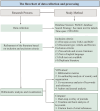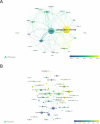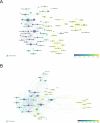Bibliometric and visualized analysis on global trends and hotspots of TAK1 in regulated cell death: 1999 to 2024
- PMID: 39474417
- PMCID: PMC11518718
- DOI: 10.3389/fimmu.2024.1437570
Bibliometric and visualized analysis on global trends and hotspots of TAK1 in regulated cell death: 1999 to 2024
Abstract
Background: Regulated cell death (RCD) is a genetically controlled form of cell death that plays an important role in organogenesis, tissue remodeling, and pathogenesis of cancers. Transforming growth factor-beta-activation kinase 1 (TAK1) is a member of the serine/threonine protein kinase family, which can respond to internal and external stimuli and participate in inflammatory responses through multiple signaling pathways and cellular processes. In the last two decades, the regulatory roles of TAK1 at the crossroads of multiple RCD pathways, including apoptosis, necroptosis, pyroptosis, and PANoptosis were revealed by 801 articles retrieved from the Web of Science Core Collection database. To analyze global research trends and hotspots concerning the role of TAK1 in RCD, the bibliometric and visualized analysis were applied in the current study.
Methods: The data for this bibliometrics study were retrieved from the Web of Science Core Collection database. The search formula was (TS=(Apoptosis) OR TS=(pyroptosis) OR TS=(Necroptosis) OR TS=(PANoptosis) OR TS=(Autophagy) OR TS=(Ferroptosis) OR TS=(cuproptosis)) AND ((TS=(TAK1)) OR TS=(MAP3K7)). The co-occurrence and co-cited analysis on basic bibliometric parameters were conducted by VOSviewer. The dual-map overlay of journals, citation bursts, keyword timelines, and keyword bursts were analyzed by CiteSpace.
Results: A total of 801 articles from 46 countries have been included in the analysis. The number of publications demonstrates a consistent increase from 1999 to 2024. The primary research institutions driving this field are Osaka University Notably, the Journal of Biological Chemistry stands out as the most popular journal in this domain. These publications collectively involve contributions from 4663 authors, with Jun Tsuji emerging as a prolific author. Jun Tsuji also gains the highest co-citation frequency. Emerging research hotspots are encapsulated by keywords, including apoptosis, NF-κB, inflammation, autophagy, and TNFα.
Conclusion: This is the first bibliometric and visualized study to analyze the global trends and hotspots of TAK1 in RCD. Based on the analysis of 801 articles, the results provide a retrospective and comprehensive visualized view of the research hotspots and frontiers of TAK1 at the crossroads of multiple RCD signaling pathways and propose ideas for guiding their future investigations in molecular mechanisms and therapeutic strategies in this field.
Keywords: CiteSpace; PANoptosis; TAK1; VOSviewer; bibliometric analysis; cancer; necroptosis; regulated cell death.
Copyright © 2024 Huang, He, Wan, Ban, Chen, Hu, Wan, Lu, Zhang and Xiong.
Conflict of interest statement
The authors declare that the research was conducted in the absence of any commercial or financial relationships that could be construed as a potential conflict of interest. The reviewer GY declared a shared affiliation, with no collaboration, with one of the authors, RL, to the handling editor at the time of the review.
Figures









Similar articles
-
TAK1 at the crossroads of multiple regulated cell death pathways: from molecular mechanisms to human diseases.FEBS J. 2025 Aug;292(15):3849-3877. doi: 10.1111/febs.70042. Epub 2025 Mar 6. FEBS J. 2025. PMID: 40047220 Review.
-
Emerging trends and research hotspots in the relationship between mast cells and atopic dermatitis based on the literature from 2001 to 2024: A bibliometric and visualized analysis.Skin Res Technol. 2024 Sep;30(9):e70053. doi: 10.1111/srt.70053. Skin Res Technol. 2024. PMID: 39234634 Free PMC article.
-
Research hotspots and frontiers of machine learning in renal medicine: a bibliometric and visual analysis from 2013 to 2024.Int Urol Nephrol. 2025 Mar;57(3):907-928. doi: 10.1007/s11255-024-04259-3. Epub 2024 Oct 30. Int Urol Nephrol. 2025. PMID: 39472403 Review.
-
Trends of mitochondrial changes in AD: a bibliometric study.Front Aging Neurosci. 2023 May 16;15:1136400. doi: 10.3389/fnagi.2023.1136400. eCollection 2023. Front Aging Neurosci. 2023. PMID: 37261264 Free PMC article.
-
Visualizing the bibliometrics of the inflammatory mechanisms in intervertebral disc degeneration.Exp Gerontol. 2024 Apr;188:112380. doi: 10.1016/j.exger.2024.112380. Epub 2024 Feb 22. Exp Gerontol. 2024. PMID: 38382680
Cited by
-
PANoptosis in neurological disorders: mechanisms, implications, and therapeutic potential.Front Immunol. 2025 Jun 11;16:1579360. doi: 10.3389/fimmu.2025.1579360. eCollection 2025. Front Immunol. 2025. PMID: 40568592 Free PMC article. Review.
-
Mapping current research status and emerging frontiers of lipidomics: a comprehensive data-mining-based study.Metabolomics. 2025 Jun 22;21(4):85. doi: 10.1007/s11306-025-02292-6. Metabolomics. 2025. PMID: 40544396 Review.
-
A potential strategy to rebuild the tumor immune microenvironment: PANoptosis.Front Immunol. 2025 Aug 4;16:1626411. doi: 10.3389/fimmu.2025.1626411. eCollection 2025. Front Immunol. 2025. PMID: 40831559 Free PMC article. Review.
References
MeSH terms
Substances
LinkOut - more resources
Full Text Sources
Miscellaneous

